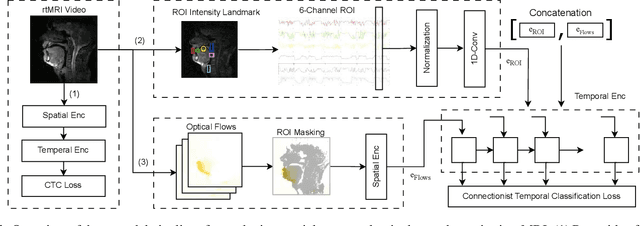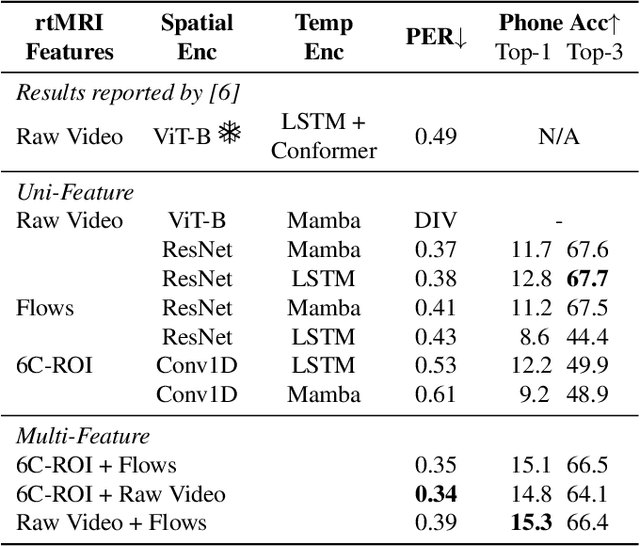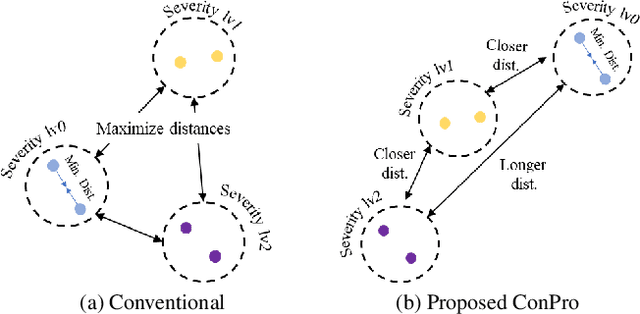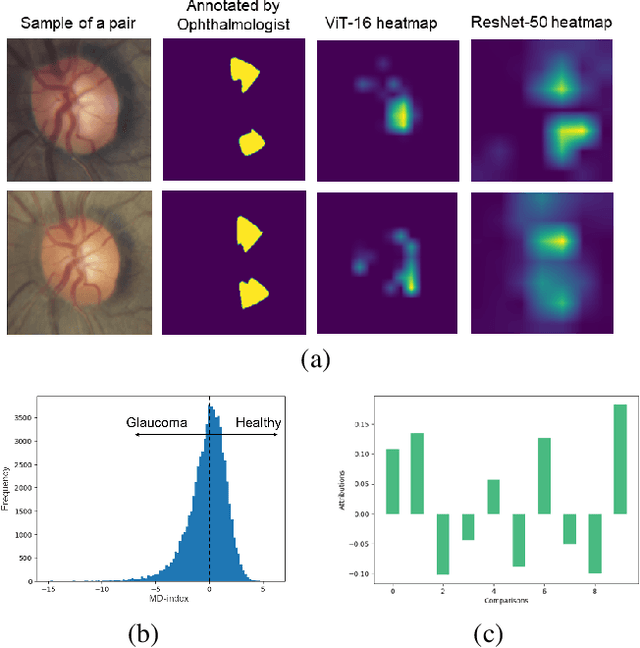Hong Nguyen
Interpretable Modeling of Articulatory Temporal Dynamics from real-time MRI for Phoneme Recognition
Sep 19, 2025



Abstract:Real-time Magnetic Resonance Imaging (rtMRI) visualizes vocal tract action, offering a comprehensive window into speech articulation. However, its signals are high dimensional and noisy, hindering interpretation. We investigate compact representations of spatiotemporal articulatory dynamics for phoneme recognition from midsagittal vocal tract rtMRI videos. We compare three feature types: (1) raw video, (2) optical flow, and (3) six linguistically-relevant regions of interest (ROIs) for articulator movements. We evaluate models trained independently on each representation, as well as multi-feature combinations. Results show that multi-feature models consistently outperform single-feature baselines, with the lowest phoneme error rate (PER) of 0.34 obtained by combining ROI and raw video. Temporal fidelity experiments demonstrate a reliance on fine-grained articulatory dynamics, while ROI ablation studies reveal strong contributions from tongue and lips. Our findings highlight how rtMRI-derived features provide accuracy and interpretability, and establish strategies for leveraging articulatory data in speech processing.
VRAE: Vertical Residual Autoencoder for License Plate Denoising and Deblurring
Sep 11, 2025Abstract:In real-world traffic surveillance, vehicle images captured under adverse weather, poor lighting, or high-speed motion often suffer from severe noise and blur. Such degradations significantly reduce the accuracy of license plate recognition systems, especially when the plate occupies only a small region within the full vehicle image. Restoring these degraded images a fast realtime manner is thus a crucial pre-processing step to enhance recognition performance. In this work, we propose a Vertical Residual Autoencoder (VRAE) architecture designed for the image enhancement task in traffic surveillance. The method incorporates an enhancement strategy that employs an auxiliary block, which injects input-aware features at each encoding stage to guide the representation learning process, enabling better general information preservation throughout the network compared to conventional autoencoders. Experiments on a vehicle image dataset with visible license plates demonstrate that our method consistently outperforms Autoencoder (AE), Generative Adversarial Network (GAN), and Flow-Based (FB) approaches. Compared with AE at the same depth, it improves PSNR by about 20%, reduces NMSE by around 50%, and enhances SSIM by 1%, while requiring only a marginal increase of roughly 1% in parameters.
Adaptive Rainfall Forecasting from Multiple Geographical Models Using Matrix Profile and Ensemble Learning
Sep 10, 2025Abstract:Rainfall forecasting in Vietnam is highly challenging due to its diverse climatic conditions and strong geographical variability across river basins, yet accurate and reliable forecasts are vital for flood management, hydropower operation, and disaster preparedness. In this work, we propose a Matrix Profile-based Weighted Ensemble (MPWE), a regime-switching framework that dynamically captures covariant dependencies among multiple geographical model forecasts while incorporating redundancy-aware weighting to balance contributions across models. We evaluate MPWE using rainfall forecasts from eight major basins in Vietnam, spanning five forecast horizons (1 hour and accumulated rainfall over 12, 24, 48, 72, and 84 hours). Experimental results show that MPWE consistently achieves lower mean and standard deviation of prediction errors compared to geographical models and ensemble baselines, demonstrating both improved accuracy and stability across basins and horizons.
Towards disentangling the contributions of articulation and acoustics in multimodal phoneme recognition
May 29, 2025Abstract:Although many previous studies have carried out multimodal learning with real-time MRI data that captures the audio-visual kinematics of the vocal tract during speech, these studies have been limited by their reliance on multi-speaker corpora. This prevents such models from learning a detailed relationship between acoustics and articulation due to considerable cross-speaker variability. In this study, we develop unimodal audio and video models as well as multimodal models for phoneme recognition using a long-form single-speaker MRI corpus, with the goal of disentangling and interpreting the contributions of each modality. Audio and multimodal models show similar performance on different phonetic manner classes but diverge on places of articulation. Interpretation of the models' latent space shows similar encoding of the phonetic space across audio and multimodal models, while the models' attention weights highlight differences in acoustic and articulatory timing for certain phonemes.
Semise: Semi-supervised learning for severity representation in medical image
Jan 07, 2025Abstract:This paper introduces SEMISE, a novel method for representation learning in medical imaging that combines self-supervised and supervised learning. By leveraging both labeled and augmented data, SEMISE addresses the challenge of data scarcity and enhances the encoder's ability to extract meaningful features. This integrated approach leads to more informative representations, improving performance on downstream tasks. As result, our approach achieved a 12% improvement in classification and a 3% improvement in segmentation, outperforming existing methods. These results demonstrate the potential of SIMESE to advance medical image analysis and offer more accurate solutions for healthcare applications, particularly in contexts where labeled data is limited.
Task-Agnostic Federated Learning
Jun 25, 2024Abstract:In the realm of medical imaging, leveraging large-scale datasets from various institutions is crucial for developing precise deep learning models, yet privacy concerns frequently impede data sharing. federated learning (FL) emerges as a prominent solution for preserving privacy while facilitating collaborative learning. However, its application in real-world scenarios faces several obstacles, such as task & data heterogeneity, label scarcity, non-identically distributed (non-IID) data, computational vaiation, etc. In real-world, medical institutions may not want to disclose their tasks to FL server and generalization challenge of out-of-network institutions with un-seen task want to join the on-going federated system. This study address task-agnostic and generalization problem on un-seen tasks by adapting self-supervised FL framework. Utilizing Vision Transformer (ViT) as consensus feature encoder for self-supervised pre-training, no initial labels required, the framework enabling effective representation learning across diverse datasets and tasks. Our extensive evaluations, using various real-world non-IID medical imaging datasets, validate our approach's efficacy, retaining 90\% of F1 accuracy with only 5\% of the training data typically required for centralized approaches and exhibiting superior adaptability to out-of-distribution task. The result indicate that federated learning architecture can be a potential approach toward multi-task foundation modeling.
ConPro: Learning Severity Representation for Medical Images using Contrastive Learning and Preference Optimization
Apr 29, 2024



Abstract:Understanding the severity of conditions shown in images in medical diagnosis is crucial, serving as a key guide for clinical assessment, treatment, as well as evaluating longitudinal progression. This paper proposes Con- PrO: a novel representation learning method for severity assessment in medical images using Contrastive learningintegrated Preference Optimization. Different from conventional contrastive learning methods that maximize the distance between classes, ConPrO injects into the latent vector the distance preference knowledge between various severity classes and the normal class. We systematically examine the key components of our framework to illuminate how contrastive prediction tasks acquire valuable representations. We show that our representation learning framework offers valuable severity ordering in the feature space while outperforming previous state-of-the-art methods on classification tasks. We achieve a 6% and 20% relative improvement compared to a supervised and a self-supervised baseline, respectively. In addition, we derived discussions on severity indicators and related applications of preference comparison in the medical domain.
Explainable Severity ranking via pairwise n-hidden comparison: a case study of glaucoma
Dec 05, 2023



Abstract:Primary open-angle glaucoma (POAG) is a chronic and progressive optic nerve condition that results in an acquired loss of optic nerve fibers and potential blindness. The gradual onset of glaucoma results in patients progressively losing their vision without being consciously aware of the changes. To diagnose POAG and determine its severity, patients must undergo a comprehensive dilated eye examination. In this work, we build a framework to rank, compare, and interpret the severity of glaucoma using fundus images. We introduce a siamese-based severity ranking using pairwise n-hidden comparisons. We additionally have a novel approach to explaining why a specific image is deemed more severe than others. Our findings indicate that the proposed severity ranking model surpasses traditional ones in terms of diagnostic accuracy and delivers improved saliency explanations.
 Add to Chrome
Add to Chrome Add to Firefox
Add to Firefox Add to Edge
Add to Edge